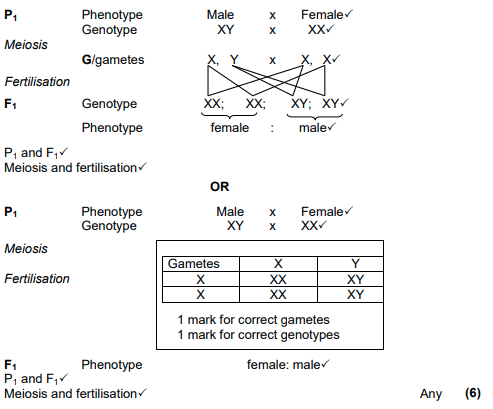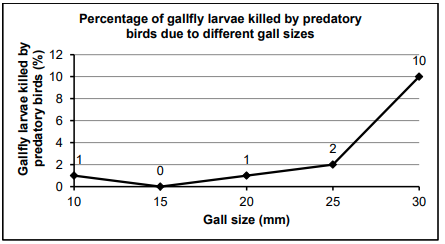LIFE SCIENCES PAPER 2 GRADE 12 MEMORANDUM - NSC PAST PAPERS AND MEMOS NOVEMBER 2021
Share via Whatsapp Join our WhatsApp Group Join our Telegram GroupLIFE SCIENCES P2
NOVEMBER 2021
MARKING GUIDELINES
PRINCIPLES RELATED TO MARKING LIFE SCIENCES
- If more information than marks allocated is given
Stop marking when maximum marks is reached and put a wavy line and 'max' in the right-hand margin. - If, for example, three reasons are required and five are given
Mark the first three irrespective of whether all or some are correct/incorrect. - If whole process is given when only a part of it is required
Read all and credit the relevant part. - If comparisons are asked for, but descriptions are given
Accept if the differences/similarities are clear. - If tabulation is required, but paragraphs are given
Candidates will lose marks for not tabulating. - If diagrams are given with annotations when descriptions are required
Candidates will lose marksIf flow charts are given instead of descriptions - Candidates will lose marks.
- If sequence is muddled and links do not make sense
Where sequence and links are correct, credit. Where sequence and links are incorrect, do not credit. If sequence and links become correct again, resume credit. - Non-recognised abbreviations
Accept if first defined in answer. If not defined, do not credit the unrecognised abbreviation, but credit the rest of the answer if correct. - Wrong numbering
If answer fits into the correct sequence of questions, but the wrong number is given, it is acceptable. - If language used changes the intended meaning
Do not accept. - Spelling errors
If recognisable, accept the answer, provided it does not mean something else in Life Sciences or if it is out of context. - If common names are given in terminology
Accept, provided it was accepted at the national memo discussion meeting. - If only the letter is asked for, but only the name is given (and vice versa)
Do not credit. - If units are not given in measurements
Candidates will lose marks. Memorandum will allocate marks for units separately. - Be sensitive to the sense of an answer, which may be stated in a different way.
- Caption
All illustrations (diagrams, graphs, tables, etc.) must have a caption. - Code-switching of official languages (terms and concepts)
A single word or two that appear(s) in any official language other than the learner's assessment language used to the greatest extent in his/her answers should be credited, if it is correct. A marker that is proficient in the relevant official language should be consulted. This is applicable to all official languages. - Changes to the memorandum
No changes must be made to the memoranda. The provincial internal moderator must be consulted, who in turn will consult with the national internal moderator (and the Umalusi moderators where necessary). - Official memoranda
Only memoranda bearing the signatures of the national internal moderator and the Umalusi moderators and distributed by the National Department of Basic Education via the provinces must be used.
SECTION A
QUESTION 1
1.1
1.1.1 C ✓✓
1.1.2 D ✓✓
1.1.3 C ✓✓
1.1.4 A ✓✓
1.1.5 B ✓✓
1.1.6 D ✓✓
1.1.7 C ✓✓
1.1.8 C ✓✓
1.1.9 D ✓✓
(9 x 2) (18)
1.2
1.2.1 Phylogenetic tree✓/cladogram
1.2.2 Peptide✓bond
1.2.3 Punctuated equilibrium✓
1.2.4 Homologous✓ structures
1.2.5 Artificial selection✓/selective breeding
1.2.6 Co-dominance✓
(6 x 1) (6)
1.3
1.3.1 Both A and B ✓✓
1.3.2 Both A and B ✓✓✓
1.3.3 None ✓✓
(3 x 2) (6)
1.4
1.4.1
- Nitrogenous base✓/Guanine/Cytosine (1)
- Deoxyribose✓sugar (1)
- Hydrogen✓ bond (1)
1.4.2 Nucleotide✓ (1)
1.4.3 Double helix✓(1)
1.4.4 (DNA) Replication✓ (1)
1.4.5
- Nucleus✓/Chromosome/Chromatid/ Chromatin/ Nucleoplasm
- Mitochondria✓
(Mark first TWO only)
(2)
(8)
1.5
1.5.1
- Testis✓ (1)
- Crossing over✓ (1)
1.5.2
- Chiasma✓ (1)
- Centromere✓ (1)
- Chromatid✓ (1)
(5) - 1.6
1.6.1 ffHh ✓ (1)
1.6.2
- FfHh✓✓ (2)
- 3✓ (1)
- h✓ (1)
- Long fingers and continuous hairline✓✓ (2)
(7)
TOTAL SECTION A: 50
SECTION B
QUESTION 2
2.1
2.1.1
- Nucleus✓/nucleoplasm (1)
- Ribosome✓/cytoplasm (1)
2.1.2 DNA contains thymine✓/T whereas RNA contains uracil ✓/U (2) (Mark first ONE only)
2.1.3 Transcription✓*
- The double helix (DNA) molecule unwinds✓
- The double-stranded DNA unzips✓/weak hydrogen bonds break
- to form two separate strands✓
- One strand is used as a template✓
- to form mRNA✓
- using free RNA nucleotides✓ from the nucleoplasm
- The mRNA is complementary to the DNA✓/ A-U, G-C
- mRNA now has the coded message for protein synthesis✓
*1 compulsory mark + Any 5 (6)
(10)
2.2
- When chromosome pair 21/chromosome 21 fails to separate✓
- during Anaphase✓
- the daughter cells (gametes) will have 24 chromosomes✓/ an extrachromosome
- When this gamete is fertilised by a normal gamete✓ with 23 chromosomes
- the zygote will have 47 chromosomes✓/3 chromosomes at position 21/ Trisomy 21
(5)
2.3
2.3.1 Body cells✓/cells in the body except the sex cells (1)
2.3.2 Autosomes✓ (1)
2.3.3
-
- One chromosome comes from the sperm✓/father
- and the other comes from the ovum✓/mother (2)
-
- Shape✓
- Size✓/length
- Position of genes✓/alleles
- Genes coding for same characteristic✓
- Location of centromere✓ Any (3)
(Mark first THREE only)
2.3.4
- Gonosomes are not identical✓/chromosomes at position 23 are not identical
- Individual 1 has XY gonosomes✓/is a male
- Individual 2 has XX gonosomes✓/is a female (3)
(10)
2.4
2.4.1
- 3✓/Three ( 1)
- 2✓/Two (1)
2.4.2 Hearing ✓ (1)
2.4.3
- Bob and Ann can both hear✓
- They have a child who is deaf✓/who has the genotype aa
- This means that each parent carries an allele for deafness✓/are heterozygous/Aa
- but it is masked✓by the dominant allele/which is for hearing (4)
2.4.4 AA✓ and Aa✓ (2)
(9)
2.6
2.6.1
- Spine✓
- Hips✓
(Mark first TWO only)
(2)
2.6.2
- A change in the sequence✓
- of nitrogenous bases✓/nucleotides in DNA (2)
2.6.3
- To check for the gene mutation✓
- and if it results in the high bone density✓ (2)
2.6.4 Produces high bone density✓/reduces the risk of bone fractures (1)
2.6.5
13/20✓ x 100✓ = 65✓% OR 7/20 x 100✓ = 35%
(100 – 35)✓ = 65✓% (3)
(10)
(50)
QUESTION 3
3.1
3.1.1
- The nucleus of the somatic cell is diploid✓ / has a full set of chromosomes/has all the genetic material whereas
- the nucleus of the sperm cell is haploid✓ /contains half the set of chromosomes/ has half the genetic material
- The somatic cell carries the desired characteristic✓ /straight hair (3)
3.1.2 To ensure that:
- The DNA (of the ovum)/characteristic of curly hair is removed✓
- Only the desired DNA is present in the clone✓
- Correct number of chromosomes is present in the clone✓ Any (2)
3.1.3 (Horse) S✓ (1)
3.1.4
- To produce organisms with desired traits✓ e.g. health, appearance, nutritious, yield, shelf life etc.
- Conservation of threatened species✓
- To create tissue/organs for transplant✓ Any
(Mark first TWO only)
(2)
(8)
3.2
3.2.1
- Biogeography✓ (1)
3.2.2
- Similar organisms✓
- that can interbreed✓
- to produce fertile offspring✓ (3)
3.2.3
- The original population /common ancestor once lived on a large continent✓
- and became separated by continental drift✓ /oceans
- There was no gene flow amongst the three populations✓ *
- Each population experienced different environmental conditions✓
- and underwent natural selection independently✓
- The individuals in each population became different✓
- genotypically and phenotypically✓
- Even if the (three) populations are mixed again✓
- they would not be able to interbreed✓ /produce fertile offspring
- forming the different species, the coyote, jackal and dingo ✓ *
2 compulsory* + any 5 (7)
(11)
3.3.1
- It decreases the number of harmful bacteria the most✓
- thereby preventing disease in cattle✓/resulting in less medical expenses
- Decreasing mortality✓/maintaining the number of cattle
- To sell✓/breed /increase profit (4)
3.3.2
- Natural selection✓ occurs
- There is variation✓/mutation in the population of bacteria
- Some are resistant to antibiotics, some are non-resistant✓
- When antibiotic is added✓ to the animal feed
- The bacteria that are non-resistant are killed by the antibiotic✓
- Those that are resistant survive and reproduce✓
- The characteristic for resistance to antibiotics is passed on to the offspring✓
- The next generation will have a higher proportion of antibiotic resistant bacteria✓Any
(6)
(10)
3.4
3.4.1
- Gall size✓ (1)
- Percentage of gallfly larvae killed✓ (1)
3.4.2
- Nutrition ✓ /food
- Protection✓
- Space✓ Any (1)
(Mark first ONE only)
3.4.3
- There is a range of (intermediate) values✓ in gall size (1)
3.4.4
- Larvae in 30mm galls are eaten more✓
- since they are more visible✓ to birds and
- contain more/larger larvae✓
OR - Larvae in galls that are 25mm and smaller are eaten less✓
- since they are less visible✓ to birds and
- contain fewer/smaller larvae✓ (3)
3.4.5
Guideline for the assessing of the graph
| CRITERIA | ELABORATION | MARK |
| Correct type of graph (T) | Line graph drawn | 1 |
| Caption of graph (C) | Both variables included | 1 |
| Axes labels (L) | Correct labels and units on X- and Y-axes | 1 |
| Scale for X- and Y-axes (S) | Equal spacing between intervals for each axis | 1 |
| Plotting of points (P) | 1 to 4 points plotted correctly All 5 points plotted correctly | 1 2 |
3.5
3.5.1 (a) X✓, Z✓ (in any order) (2)
(Mark first TWO only)
3.5.1 (b) C✓ (1)
3.5.2
- The pelvis is long✓
- and narrow✓ (2)
3.5.3
- The spine✓
- is S-shaped for the bipedal organism✓
- and C-shaped for the quadrupedal organism✓
OR - The foramen magnum✓
- is in a more forward position in bipedal organisms✓
- and in a backward position in quadrupedal organisms✓ (3)
(Mark first ONE only)
(8)
(50)
TOTAL SECTION B: 100
GRAND TOTAL: 150

